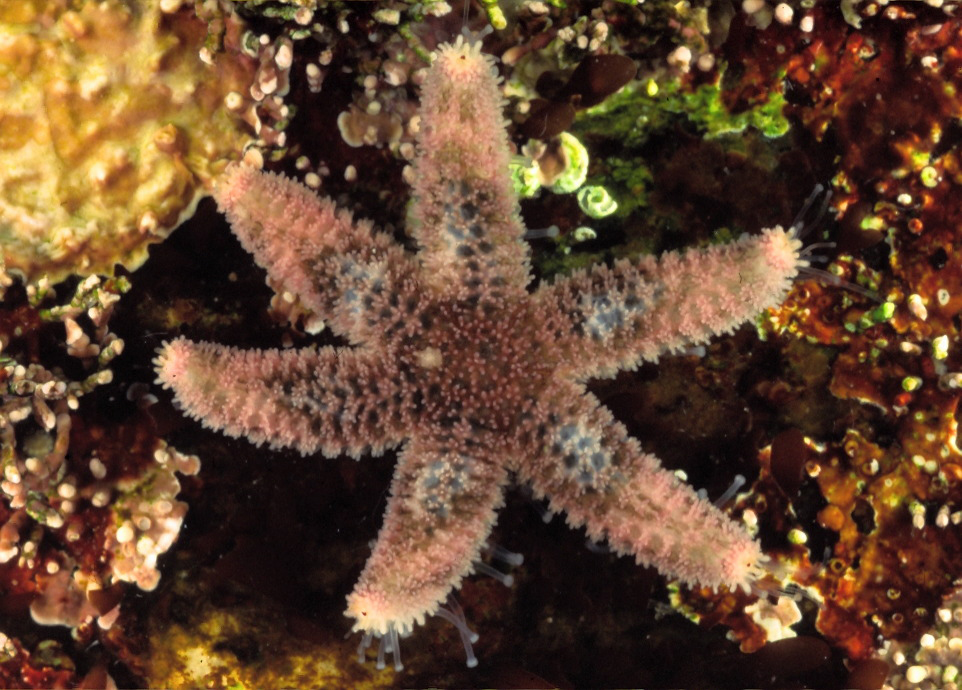- Leptasterias pusilla
Taxobox

name = "Leptasterias pusilla"
regnum =Animal ia
phylum =Echinodermata
classis =Asteroidea
ordo =Forcipulatida
familia =Asteriidae
genus = "Leptasterias "
species = "pusilla"
binomial = "Leptasterias pusilla"
binomial_authority = (Fisher, 1930)"Leptasterias pusilla" is a small, six-rayed
sea star .Description
"A dainty little six-rayed seastar with a total arm spread usually under 2 cm."Ricketts, Edward, et al (1985). "Between Pacific tides." Stanford University Press, 60-61. ISBN 0804720681.]
Distribution
"The genus "Leptasterias" originates in the Arctic,"Himmelman, J.H., et al. "Brooding behaviour of the northern sea star "Leptasterias polaris"." "Marine Biology." 1982;68(3):235-240.] and within the United States, this species can be found in the middle
intertidal zone of rocky shores of central California, including San Mateo, Santa Cruz, and Monterey counties. "Leptasterias pusilla" is "...generally believed to be the most abundant species in the subgenus ["Hexasterias"] along the North American Pacific coast from central California to southern Alaska."Hrincevich, Adam, et al. [http://icb.oxfordjournals.org/cgi/reprint/40/3/365 "Phylogenetic Analysis of Molecular Lineages in a Species-Rich Subgenus of Sea Stars (Leptasterias Subgenus Hexasterias)."] "Amer Zool." 2000;40:365–374.]Behavior
"Leptasterias pusilla" may be quite numerous in the middle intertidal zone of rocky shores, typically moving around on the top of rocks at night after hiding under them during the day.
Diet
Poikilotherms primarily feed on small
gastropods , with only minimal metabolic rate fluctuations in response to changes in ambient temperature.Fuhrman, Geraldine. [http://www.jgp.org/cgi/reprint/42/4/715.pdf "Oxygen consumption of animals and tissues as a function of temperature."] "The Journal of General Physiology." 1958:715-722.] Additionally, and contrary to previous research, it has been demonstrated that females do feed while brooding.Blankley, W.O., and G. M. Branch. [http://www.int-res.com/articles/meps/20/m020p171.pdf "Co-operative prey capture and unusual brooding habits of Anasterias rupicola (Verrill) (Asteroidea) at sub-Antarctic Marion Island."] "Marine Ecology - Progress Series." 1984;20:171-176.]Reproduction
The "Leptasterias pusilla" "...breeding habits are famous." The mother keeps the eggs and larvae in
brood clusters around her mouth area until the larvae reach adult form. "Ovigerous females may be found in January and February, with the minute offspring seen in tide pools during February and March."Further reading
*Langstroth, Lovell and Libby (2000). "A Living Bay: The Underwater World of Monterey Bay." University of California Press. ISBN: 0520221494.
*McEdward, Larry and Benjamin G. Miner. [http://rparticle.web-p.cisti.nrc.ca/rparticle/AbstractTemplateServlet?journal=cjz&volume=79&year=&issue=&msno=z00-218&calyLang=eng "Larval and life-cycle patterns in echinoderms."] "Can. J. Zool." 2001;79(7):1125–1170.
*Worley, et al. [http://www.biolbull.org/cgi/reprint/153/1/237 "Seasonal patterns of ganietogenesis in a North Atlantic brooding asteroid, Leptasterias tenera."] "Biol. Bull." August 1977;153:237-253.Footnotes
External links
*Hinton, Sam. [http://gondolin.ucsd.edu/cgi-bin/pview.exe?CISOROOT=/ceo-sioa&CISOPTR=11537&CISORESTMP=/qbuild/template1.html&CISOVIEWTMP=/qbuild/template2.html "Little Six-rayed Starfish - Leptasterias pusilla."] "Scripps Institution of Oceanography Archives." 1969.
Wikimedia Foundation. 2010.
